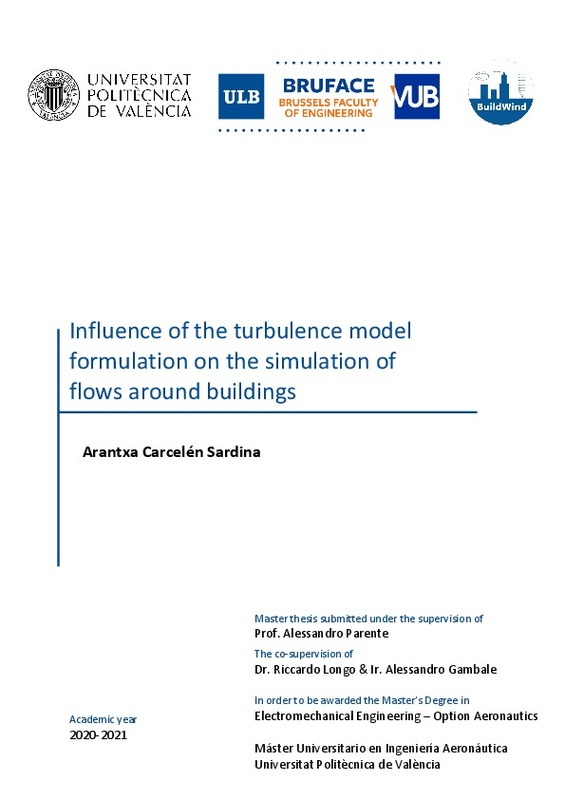JavaScript is disabled for your browser. Some features of this site may not work without it.
Buscar en RiuNet
Listar
Mi cuenta
Estadísticas
Ayuda RiuNet
Admin. UPV
Influence of the turbulence model formulation on the simulation of flows around buildings
Mostrar el registro sencillo del ítem
Ficheros en el ítem
| dc.contributor.advisor | Navarro García, Roberto
|
es_ES |
| dc.contributor.author | Carcelén Sardina, Arantxa
|
es_ES |
| dc.date.accessioned | 2021-07-29T06:53:33Z | |
| dc.date.available | 2021-07-29T06:53:33Z | |
| dc.date.created | 2021-07-05 | |
| dc.date.issued | 2021-07-29 | es_ES |
| dc.identifier.uri | http://hdl.handle.net/10251/170799 | |
| dc.description.abstract | [EN] The population tends to concentrate on big cities, leading to a problem of land for housing. High-rise buildings can host many people in little ground, but these structures present different challenges, an important factor for their design is the wind. The aerodynamic loads can cause strong vibrations on the upper side, and the air may flow to the lower part and cause disturbance to pedestrians. In this thesis different analysis of the flow field around buildings are conducted. A simple structure is studied to test different models used in Computational Fluid Dynamics (CFD) simulations since experimental data is available. The numerical solution is obtained with the steady Reynolds-Averaged Navier-Stokes (RANS) method and the unsteady approach (URANS), since this case is intrinsically steady both results are analogous. About the turbulence, the standard k-epsilon model is chosen in a version improved by the comprehensive approach which addresses two inconsistencies generated by the RANS approximations. For the good implementation of this model, the Building Influence Area (BIA) concept is integrated to apply the Non-Linear Eddy Viscosity (NLEV) model within it. The improvements of this model will be shown by comparing its results with traditional turbulence models as the k- and the SST k-ω. Once the comprehensive approach is validated, it is implemented in another simple geometry and later in a high-rise building in order to analyse the flow behaviour. The separation bubble at the top, the wake, the base vortex and the corner streams are visualized. The comprehensive approach provides accurate results, but the simulation time is also higher. Moreover, the steady simulations require a lower computational cost, however, an unsteady simulation is advisable for the skyscraper to study dynamic phenomenons that could induce harmful vibrations and fatigue. | es_ES |
| dc.description.abstract | [ES] En esta tesis se realizan diferentes análisis del flujo alrededor de edificios. Se estudia una estructura simple para probar diferentes modelos utilizados en simulaciones de Dinámica de Fluidos Computacional (CFD), ya que se dispone de datos experimentales. La solución numérica se obtiene tanto de forma estacionaria como transitoria. Sobre la turbulencia, se elige el modelo k-epsilon estándar en una versión mejorada por el ¿enfoque integral¿. Las mejoras de este modelo se mostrarán comparando sus resultados con modelos de turbulencia tradicionales. Una vez validado el enfoque integral, se implementa en otra geometría simple y luego en un edificio de gran altura para analizar el comportamiento del flujo. | es_ES |
| dc.format.extent | 111 | es_ES |
| dc.language | Inglés | es_ES |
| dc.publisher | Universitat Politècnica de València | es_ES |
| dc.rights | Reserva de todos los derechos | es_ES |
| dc.subject | CFD | es_ES |
| dc.subject | Simulación de viento | es_ES |
| dc.subject | Reynolds-Averaged Navier-Stokes (RANS) | es_ES |
| dc.subject | Turbulencia | es_ES |
| dc.subject | Enfoque integral | es_ES |
| dc.subject | Edificio de gran altura | es_ES |
| dc.subject | Wind simulation | es_ES |
| dc.subject | Turbulence | es_ES |
| dc.subject | Comprehensive approach | es_ES |
| dc.subject | High-rise building | es_ES |
| dc.subject.classification | MAQUINAS Y MOTORES TERMICOS | es_ES |
| dc.subject.other | Máster Universitario en Ingeniería Aeronáutica-Màster Universitari en Enginyeria Aeronàutica | es_ES |
| dc.title | Influence of the turbulence model formulation on the simulation of flows around buildings | es_ES |
| dc.title.alternative | Influencia de la formulación del modelo de turbulencia en la simulación de flujos alrededor de edificios | es_ES |
| dc.type | Tesis de máster | es_ES |
| dc.rights.accessRights | Abierto | es_ES |
| dc.contributor.affiliation | Universitat Politècnica de València. Departamento de Máquinas y Motores Térmicos - Departament de Màquines i Motors Tèrmics | es_ES |
| dc.contributor.affiliation | Universitat Politècnica de València. Escuela Técnica Superior de Ingeniería del Diseño - Escola Tècnica Superior d'Enginyeria del Disseny | es_ES |
| dc.description.bibliographicCitation | Carcelén Sardina, A. (2021). Influence of the turbulence model formulation on the simulation of flows around buildings. Universitat Politècnica de València. http://hdl.handle.net/10251/170799 | es_ES |
| dc.description.accrualMethod | TFGM | es_ES |
| dc.relation.pasarela | TFGM\145761 | es_ES |
Este ítem aparece en la(s) siguiente(s) colección(ones)
-
ETSID - Trabajos académicos [8685]
Escuela Técnica Superior de Ingeniería del Diseño






